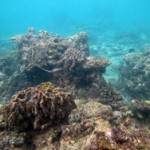While Siti and others explored the delights at a local fishing village at Pa Klok, the rest of us visited Koh Pling, Sirinat Marine National Park. It was a chance for us to cool off from the dry season heat.
Located just south of Phuket airport on the north-western tip of Phuket Island, Sirinat Marine National Park covers an area of around 90 square km. After a 50 minute coach ride from Patong (our WSC venue), we arrived at the park and popular Nai Yang Beach. The instructions were that the main seagrass and coral is best seen surrounding Nai Yang Island, a short (1.4 km) walk along the beach to the headland. We navigated our way through the rows of sun lounges and trekked along the beach.
On arrival at Nai Yang Island, it was pleasing to find Thalassia hemprichii and Cymodocea rotundata meadows covering much of the shallow reef flat to the south. Thalassia hemprichii predominated and looked in pretty good condition, although there were very few invertebrates to be seen. It was soon evident that the area is regularly gleaned with many local villagers taking advantage of the low tides. Discarded gill nets and fish traps were also scattered over the intertidal meadow. The Cymodocea rotundata was not looking so great, with nearly 75% cover of epiphytic algae on the leaves.
We were all a little shocked however, with the condition of the coral reef. The brochures said “the coral reefs present in the bay are some of the most pristine found in Phuket province”, but this was not to be. After clambering over rocks to reach the reef edge, I asked Mike Durako where was the coral reef we came to see, and he said “this is it”. It was a very sad reef. Live coral cover was probably <1%. Much of the coral reef in the area was devastated by the 2004 Boxing Day tsunami and what appears to be more recent bleaching events (with chronic nutrient inputs discharging from the adjacent resorts). Coral recruitment was nearly non-existent. Paul Erftemejier took great glee in photographing the reef condition so he could use it in his presentations of what a poor reef looks like. It is hoped that this reef which is so important to the subsistence fishery of the area improves in the near future.
With a large northeast monsoon storm buidling in the distance, we thought it best to head back. We trekked back along to beach in time to grab a quick beer and a game of “uno” before our coach ride back to Patong.
Len McKenzie








